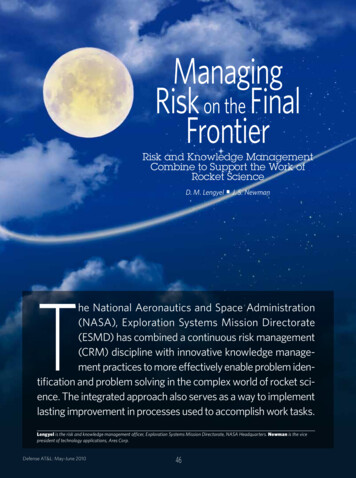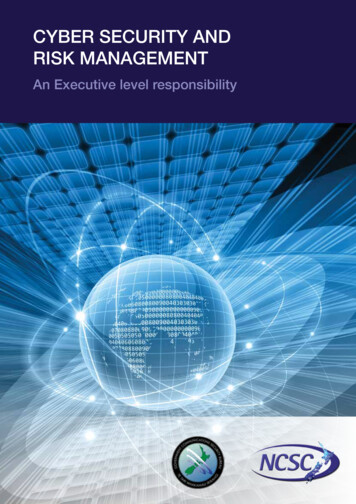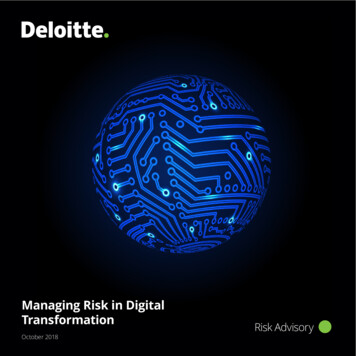
Transcription
ManagingRisk on the FinalFrontierRisk and Knowledge ManagementCombine to Support the Work ofRocket ScienceD. M. Lengyel J. S. NewmanThe National Aeronautics and Space Administration(NASA), Exploration Systems Mission Directorate(ESMD) has combined a continuous risk management(CRM) discipline with innovative knowledge management practices to more effectively enable problem identification and problem solving in the complex world of rocket science. The integrated approach also serves as a way to implementlasting improvement in processes used to accomplish work tasks.Lengyel is the risk and knowledge management officer, Exploration Systems Mission Directorate, NASA Headquarters. Newman is the vicepresident of technology applications, Ares Corp.Defense AT&L: May-June 201046
The exploration risk landscape is, indeed, challenging with NASA’s competing constraints of operating safely and staying within the budget, all while replacing the spaceshuttle, maintaining a balanced agency workforce, resupplying the International SpaceStation, exploring beyond low Earth orbit, developing advanced technologies, andstimulating the commercial space sector. Continuous risk management and knowledge management at NASA (and in the federal government) have come a long wayduring the past 10 years, and innovations continue with the advent of greater socialnetworking capabilities with Web 2.0.47Defense AT&L: May-June 2010
Figure 1. IRKM ElementsContinuous RiskManagementProcess 2.0KnowledgeCaptureand TransferKnowledge-BasedRisksRiskManagementCase StudiesWiki-EnabledTeamsDecision SupportRiskapediaThe Integrated Risk and KnowledgeManagement SystemESMD’s Integrated Risk and Knowledge Management(IRKM) System was initiated in 2006. The foundation of thesystem is CRM, a technical management process that is partof the systems engineering discipline. CRM requires an iterative evaluation of events that could prevent you from meetingyour objectives coupled with proactive implementation ofmeasures to control or mitigate those risks. An importantand novel aspect of the IRKM approach is using risk recordsresulting from the CRM process to initiate an assessmentof what knowledge to transfer to risk owners to help themsolve their problem, then following up to capture the actualstrategy or measures used to mitigate the risk. Risk recordsused in this fashion provide a “cueing function” similar toan aircraft sensor cueing a weapons system sensor. In theIRKM System, CRM informs knowledge management, andknowledge management becomes the enabler of CRM.Continuous Risk ManagementCRM is an iterative process that identifies, analyzes, plans,tracks, controls, communicates, and documents riskthrough all life cycle phases of an organization’s productdevelopments. ESMD uses an enterprise risk managementapproach and a common framework for identifying, analyzing, communicating, and managing risks for the directorateand its performing organizations. Risks are communicatedvertically through a well-defined escalation process, whilehorizontal integration occurs through a multi-tiered riskmanagement working group and board structure. This network of risk managers is also used to communicate lessonslearned and best practices—referred to as a “central nervous system” for information flow that is critical for knowledge sharing. Establishing a robust CRM process must beaccomplished first as it provides the foundation of the entireIRKM system.Knowledge-Based RisksESMD risk records provide the context for knowledgebased risks—Web-based, multi-media knowledge bundlesthat provide users with expert advice on risk control andmitigation strategies for specific technical risks. ESMDdefines a knowledge-based risk as a risk record, with associated knowledge artifacts, that provides a storytellingnarrative of how the risk was mitigated and what workedor did not work. A knowledge-based risk is also a meansof transferring knowledge within the CRM process. As keyrisks are mitigated, particularly risks that are likely to recuracross other programs in ESMD, knowledge is captured andtransferred. Knowledge-based risks identify the effectiveness of mitigation activities, specifically in terms of cost,schedule, and technical performance. Instead of a “collect,store, and ignore” approach, knowledge-based risks forman active collection of lessons learned that are continuallyreused and updated.ESMD uses an enterpriserisk managementapproach and a commonframework for identifying,analyzing, communicating,and managing risks forthe directorate and itsperforming organizations.Defense AT&L: May-June 2010The second key concept of the IRKM System iswork process improvement. Knowledge management (KM) practices enable ESMD programs toeffectively reflect on process performance andprovide a structure for process optimization. Riskfinds a breeding ground in less-than-adequateprocess performance whether they are business,engineering, or technical management-orientedprocesses. To address those risks head-on requiresusing one or more KM practices or interventions.KM enhances the risk management process, whichthen helps personnel work more effectively. Hence,the interlocking concepts of risk management—work process optimization and knowledge management—are tightly coupled and mutually supportive. The following paragraphs provide a quicklook at key elements of the system. As shown inFigure 1, the IRKM process flows from the domainof continuous risk management (home plate) andnotionally moves around the bases.48
Examples of knowledge-based topics seen in NASA includecomposite overwrap pressure vessels (lightweight storagevessels that require careful handling and are a potentialhazard); nutation time constant (sloshing propellant duringcoast phase of launch); tin whiskers (metallic crystal growthon circuit boards); and EVA gloves (damage to spacesuitgloves during extra-vehicular activity).The ESMD wikienvironment enableshorizontal communication,collaboration, andRiskapediaThe Riskapedia wiki space is intended to assist ESMD programs, projects, managers, and workers in implementing lifecycle risk management practices and discipline. Riskapediaprovides extensive content (tools, techniques, best practices,videos, and lessons learned) addressing the fundamental“blocking and tackling skills” of risk management: risk identification, risk assessment, and risk control and mitigationplanning. The resource is a “hard hat area” that is intendedto be under construction for life. The space has been populated with expert-developed content that is intended toevolve over time as users and contributing editors engagein ongoing construction of subject matter articles. Riskapedia is all about user interaction, conversation, evolution,and, ultimately, the accomplishment of work. Users have theopportunity to rate and discuss content, provide or authorcontent (as a contributing editor), ask questions of experts,and use content in the performance of work and the management of risks.knowledge sharing acrossthe ESMD directorate.past programs successful will hopefully enhance the technical curiosity of engineers developing future space systemsand make their programs equally robust.Process 2.0The IRKM System also has an important work-process-assistelement called Process 2.0, or P2.0, which is in part modeled on the U.S. Army after-action review process. P2.0sare process-focused, collegial, structured reflection events.There has been huge demand for the P2.0 events, which assist teams in examining all aspects of a given process, including stakeholders, inputs, outputs, and products. P2.0 eventsuse critical process mapping, structured brainstorming techniques, and process failure modes and effects analysis toidentify and address work process issues. As an option, P2.0users can take advantage of a Web-based collaboration toolsuite—also used by DAU to support various projects. Thetool provides a simple-to-use information capture capability that increases the volume and speed of idea capture andalso supports alternative analysis. Most important, the P2.0method demands and enforces disciplined thinking to driveout actionable process improvements for the team. P2.0shave been used to assist a diverse set of team processesranging from vibro-acoustic coupled-loads analysis, to theagency independent assessment processes, to a simple integration meeting gone awry. In every case, the result has beenrapid, transparent, team-authored process improvement.Riskapedia is divided into several sections. The Risk Identification section provides convenient checklists for identifyingtypical system, programmatic, and integration risks. The RiskAssessment section contains qualitative and quantitativetools and methodologies for analyzing, understanding, andcommunicating risks. Lastly, the Control and Mitigation section provides expert knowledge and guidance for mitigating and controlling risk in specific areas—and this section isstructured very much like the Defense Acquisition University’s ACQuipedia toolkit.Risk Management Case StudiesESMD risk records illuminate top engineering managementand technical issues. Risk management case studies providetraining and insight into how similar problems have been addressed in past NASA programs. Each case is structuredto highlight key transferrable aspects of risk management.Transferrable principles include risk identification, evaluation, and mitigation planning. The proper application of riskmanagement principles can help manage life cycle costs,development schedules, and technical scope, resulting insafer and more reliable systems for NASA’s future programs.Our first case study addressed the Space Shuttle Program’sSuper Lightweight Tank development. Two follow-on casesnow in development examine test and verification management approaches employed on the International Space Station and Space Shuttle Return-to-Flight management andtechnical challenges. Looking into the future, engineers willface similar risks. Examining the critical thinking that madeKnowledge Capture and TransferKnowledge capture and transfer activities are designed todocument project execution lessons learned and best practices in a contextual manner using a conversation-based format. While overlapping in some respects, knowledge captureand transfer differs from P2.0 in that it focuses on projectexecution rather than recurrent process implementation.Knowledge capture and transfer is an abrupt departure fromthe notion of lessons-learned databases that often have beenhard to use, typically fragment the story, and most regrettably, lack context. Knowledge capture and transfer also rejectsthe notion of asking participants to fill out questionnaires—something no one enjoys doing. Rather, knowledge capture49Defense AT&L: May-June 2010
Wiki implementation is supported by rapid business process analysis to assist in developing the team charter, identifying stakeholder membership, and refining the knowledge architecture. The wiki provides teams an easy-to-use,flexible interface to collaborate on documents, conductdiscussions, manage calendars, locate information, and,most important, work more effectively.and transfer uses the most natural modality—conversation,but carefully structured and controlled conversation. Project risk records are used to guide the initial interviews. Athematic framework is evolved to identify key issue areasand communicate them in an issue/opportunity fishbonediagram similar to that shown in Figure 2.Decision SupportDecision-support servicesinclude training teams inKnowledge CaptureSummary of Issues and Opportunitiesdeveloping decision dataEach identified issue/opportunity is indexed to framework themes as appropriatepackages (e.g., rationale,(an individual issue may appear in more than one category)cost and schedule risk1.0 Early Design2.0 Engineering3.0 Test andanalysis, tradeoff analyand RequirementsDevelopmentVerificationsis, and other supportingdocumentation) neces2.1 Process/Product3.6 Integrated1.1 Maturity3.1 Resourcessary to conduct formalControlTestinganalysis of alternatives2.2 Development3.7 Black/White3.2 TRL Evaluations1.2 Clarityand/or successfully meetSystem SupportBox Testingthe requirements of mile1.3 Interface2.3 Development3.3 Engineeringstone reviews and/orDefinitionSystem CapacityAnalysisdecision forums (boards1.4 Planning2.4 Development3.4 TestingComplexitySystem SuitabilityComplexityand panels). In addition,decision-support activi1.5 Technology2.5 Development3.5 ValidationRoadmapSystem Usabilityof Modelsties include training andSuccess/FailureCaused Bymentoring in specific toolsAdequate/Inadequate.4.5 Contractorand methods to aid theManagementdecision process, includ4.4 Personnel5.4 Strong6.4 Programmaticing uncertainty modeling,ManagementTeam InterfacesInterfacesexpert elicitation, analyti4.3 Continuous5.3 Commitment to6.3 Contractualcal hierarchy process, andMonitoring ProcessesQuality AssuranceCommitmentsother methods similar to4.2 Software5.2 Cooperation6.2 Geographicallythose contained in DAU’sDevelopment ExperienceDistributed ProgramProgram Managers e-Tool4.1 Planning,6.1 Resource LimitsKit. Finally, ESMD is devel5.1CommunicationPlanning, Planning(Personnel, Budget,oping a cadre of trainedFacilities, etc.)facilitators to assist teams6.0 Response to4.0 Management5.0 Leadershipin using Web-based deciProgram Constraintssion-support technologyto support team brainIndividual issues are synopsized and aggregated, and a storming, prioritization, and alternative analysis.composite analysis is provided. Results are rapidly providedto stakeholders using a variety of communication modes, Applicability to Other Organizationsincluding briefings, design review checklists, peer assists, The IRKM System continues to evolve and innovate toknowledge cafes (small group brainstorming), and video in- facilitate integration, collaboration, and effective workterviews. An edited report is also developed as an archive process implementation across the complex and evolving ESMD enterprise. The fundamental concepts and apand made available electronically to management.proach have been broadly scalable within ESMD’s diversework processes (e.g., budget analysis, design and systemsWiki-Enabled TeamsThe ESMD wiki environment enables horizontal communica- engineering, operations planning) and, indeed, could betion, collaboration, and knowledge sharing across the ESMD applied across (or within) any government, commercial,directorate. More than 350 wikis provide a multi-functional or academic enterprise.tool-set to assist ESMD teams in accomplishing work. Animportant part of exploiting the wiki technology has been The authors welcome comments and questions and can behelping teams critically examine their work processes and contacted at dlengyel@hq.nasa.gov and snewman@information architecture, which is then mapped into the tool. arescorporation.com.Figure 2. Aggregation of Issues/Opportunities for ImprovementDefense AT&L: May-June 201050
Wiki implementation is supported by rapid business pro-cess analysis to assist in developing the team charter, iden-tifying stakeholder membership, and refining the knowl-edge architecture. The wiki provides teams an easy-to-use, flexible interface to collaborate on documents, conduct discussions, manage calendars, locate information, and,











